What can the CGC Census tell us about all those ungraded comics?
Beyond CGC Averages
This article is Part 2 in a continuing series. Part 1 is available here. As previously shown, using the CGC Census to calculate the average CGC grade by decade, year, or by book is not an accurate reflection of the average condition for all copies in existence. The CGC Census generally reflects a strong portion of the best copies known, a lighter portion of the existing mid-grade copies, and usually a very small portion of the existing low grade copies. A more representative sample of all copies in existence would only be possible for a comic book which is worth CGC grading in all conditions. More specifically, any comic book which reflects a significant difference in prices between the CGC grades of 0.5 and 1.0 – a difference far above the cost of CGC grading itself - would be worth CGC grading in all conditions.
Finding The Right Starting Point
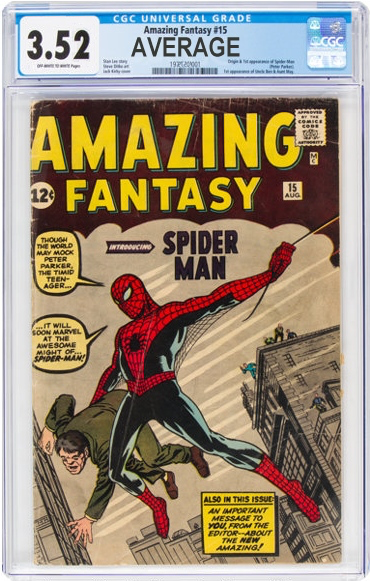
There are very few comic books which currently have significant value differences between the CGC 0.5 and CGC 1.0 grades, but one known example is Amazing Fantasy #15 (Marvel, 1962) – the first appearance of Spider-Man. More than $2,000 separates the GPAnalysis.com 12-month average price for CGC 0.5 ($7,115) and the 12-month average price for CGC 1.0 ($9,279). Having such significant value, even at the lowest CGC grades, provides the incentive for copies of Amazing Fantasy #15 to be submitted to CGC in all grades. The average CGC grade for Amazing Fantasy #15 is 3.52, far below the overall 1962 average CGC grade of 5.97. For those comics from 1962 submitted to CGC only 10 (or fewer) times, the average CGC grade is 8.27. These averages of nearly 6.0 and over 8.0 do not reflect a true sampling of 1962 comic books and are primarily a representation of the highest grades for each book worth submitting to CGC and recorded in the CGC Census.
Looking At Just One Year Of Data
Establishing Amazing Fantasy #15 as a book of interest for this analysis, the CGC Census for all 1962 comic books should be evaluated to provide a baseline for comparison.
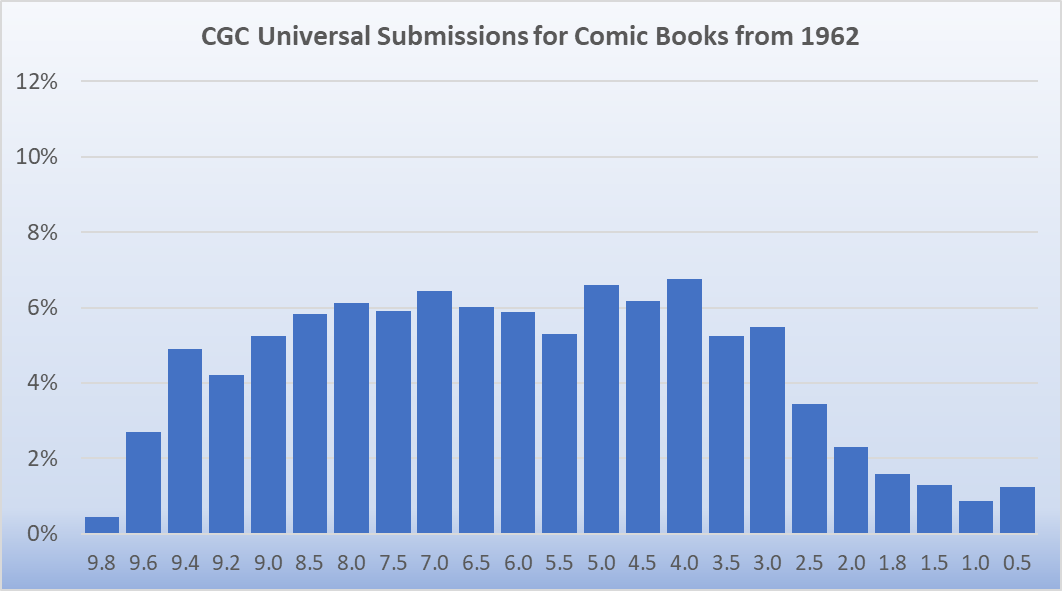
The temptation when examining the chart of CGC Universal Submissions for 1962 comic books in each grade is to assume that roughly equal numbers of ungraded comics may also exist for each grade from 3.0 to 9.4 for comic books from 1962 based upon the CGC Census grade distributions. This is a mistaken assumption because there is little incentive to submit mid-grade copies of most 1962 comic books, and there is even less incentive to submit low grade copies to CGC for those books.
When the financial incentive does exist for CGC grading at all conditions, the distribution of grades on the CGC Census is quite different - as shown in the chart for Amazing Fantasy #15. There are more reasons to presume that the CGC Census grade distributions for Amazing Fantasy #15 are also applicable to most 1962 comic books in existence, not just those copies of other 1962 comics already submitted to CGC.

One Comic Leads, Others Follow Close Behind
To test the assumption that most copies in existence are closer in grade distribution to Amazing Fantasy #15, two other 1962 comic books are needed which have also been submitted frequently to CGC in CGC 1.0 and CGC 0.5 conditions. Amazing Fantasy #15 has the highest number of CGC 1.0 and 0.5 submissions from 1962, and the next two most often submitted CGC 1.0 and CGC 0.5 books from 1962 are Incredible Hulk #1 and Journey Into Mystery #83.
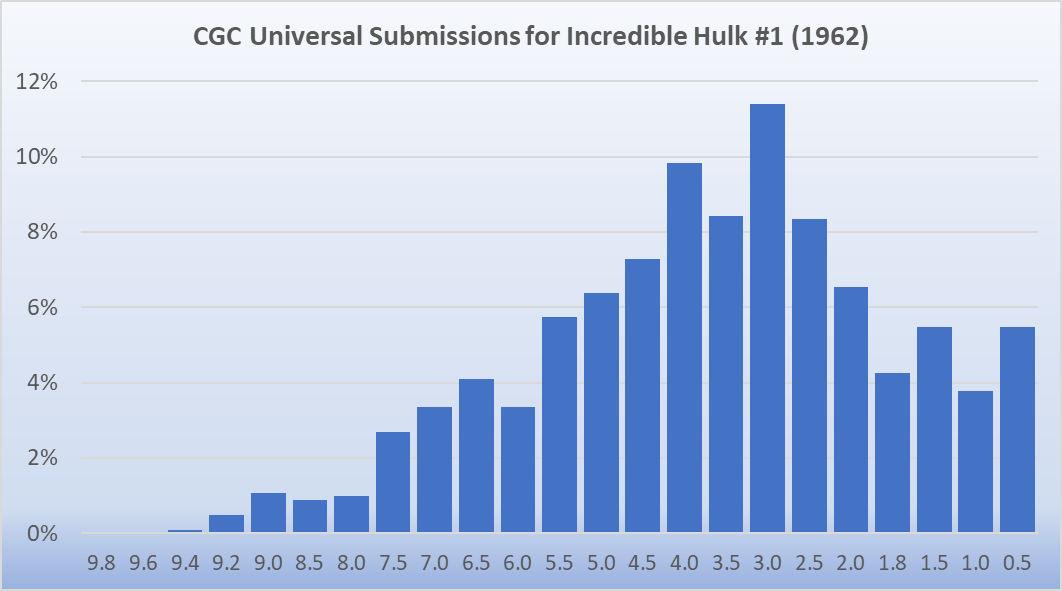
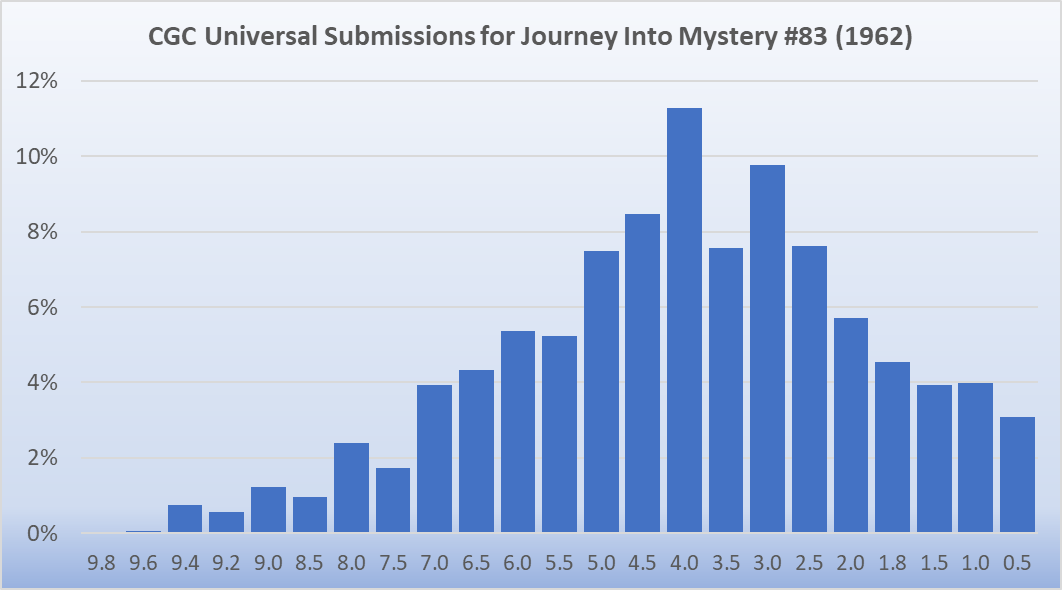
Establishing A Normal Distribution
Comparing these charts, the CGC Census grade distributions for Incredible Hulk #1 and Journey Into Mystery #83 are much closer to those of Amazing Fantasy #15 than the 1962 CGC Census numbers, but their similarities may be difficult to evaluate as separate charts. To demonstrate just how close the Incredible Hulk #1 and Journey Into Mystery #83 CGC Census distributions are to Amazing Fantasy #15, the cumulative percentages are shown for each grade in the chart below.

Looking For The Exceptions
Taking this test of the CGC Census further, the grades for 1962 comic books submitted the least often should reflect almost no copies in the CGC 1.0 or 0.5 category, since they would be unlikely to be financially worth submitting, and the overall cumulative percentages for the least submitted 1962 comic books would likely reflect higher grades than the 1962 overall average. The CGC Census grade distribution for 1962 comic books submitted 10 times (or fewer) is shown below. Note that the y-axis (percentages) requires a range from 0% to 25% to accommodate the grade distribution as opposed to 0% to 12% range needed for the similar charts in this article.
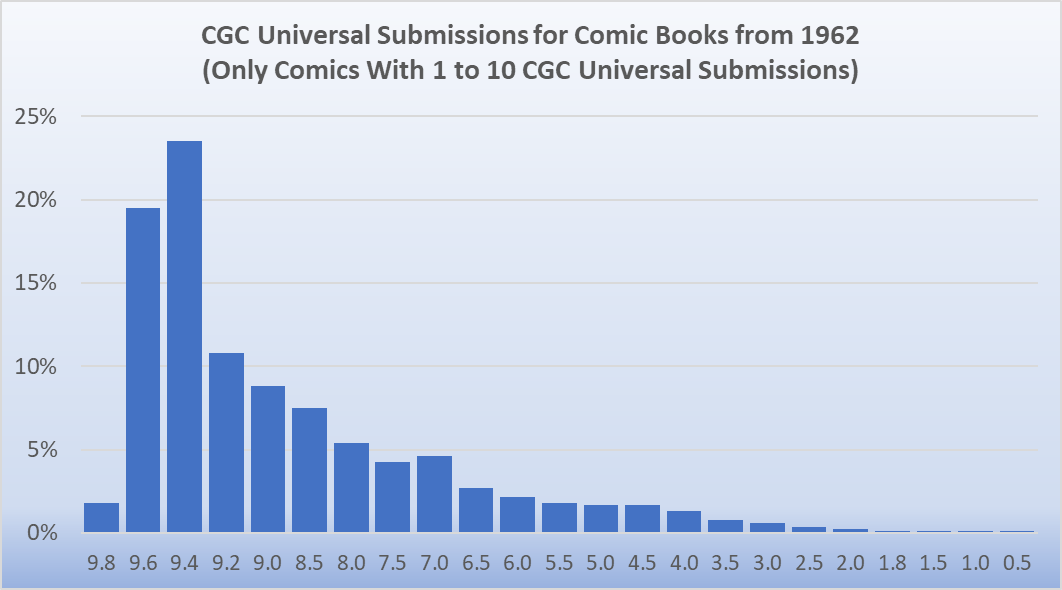
Including this additional information for the lowest submitted 1962 comic books in the cumulative percentages chart clearly shows that 1962 comic books submitted to CGC 10 times (or fewer) are overwhelmingly chosen for their high grade conditions. It makes financial sense to submit only the highest grade copies when the books are otherwise not valuable enough to be submitted.
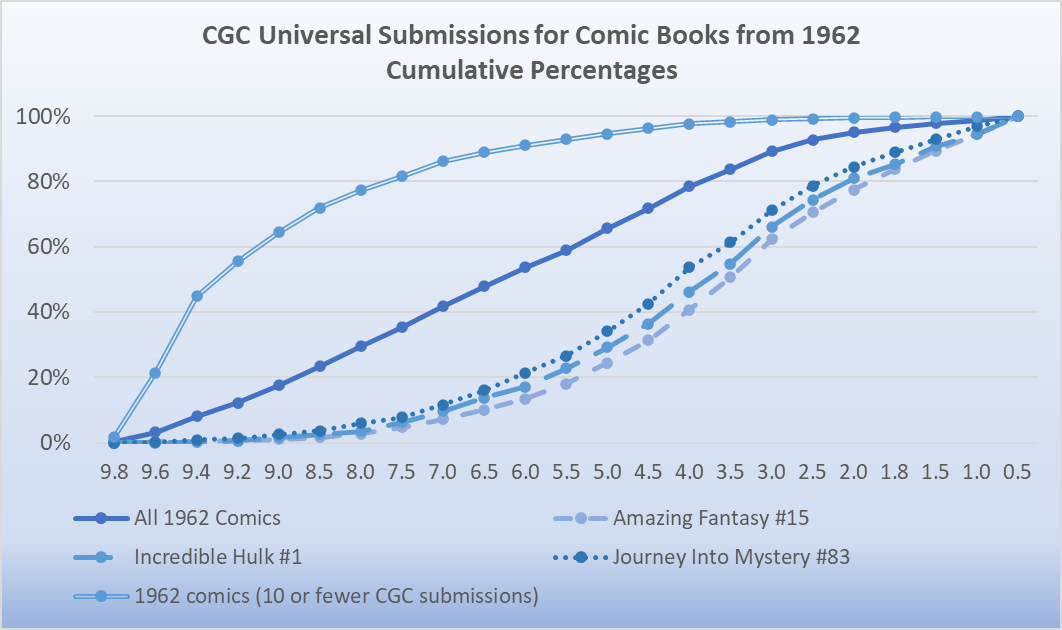
Preventing Tunnel Marvel Vision
One objection to the selection of the three 1962 comic books might be that only Marvel comics were singled out in the analysis thus far. In fact, the twelve most submitted comic books for 1962 are all Marvel comics, and the first non-Marvel 1962 comic has the 13th most universal CGC submissions - Aquaman #1 (D.C. Comics). According to GPAnalysis.com, there is no difference in the values of CGC 1.0 Aquaman #1 and CGC 0.5 Aquaman #1, which would indicate that low grade copies of Aquaman #1 are unlikely to be submitted to CGC due to a lack of a financial incentive. This is in contrast to the submission of CGC 1.0 and 0.5 grades for the three Marvel comics.
The cumulative percentages for the CGC Census grade distributions for Aquaman #1 may be slightly above the individual Marvel books profiled at the highest grades (since there are no low grades to balance against the highest grades), may be quite similar to the cumulative percentages of the average 1962 comic book in the mid-grades and there would be no significant percentages to chart at the lowest grades. These three predictions for the CGC Census are proven correct by the numbers shown in the cumulative percentages chart which now includes Aquaman #1.
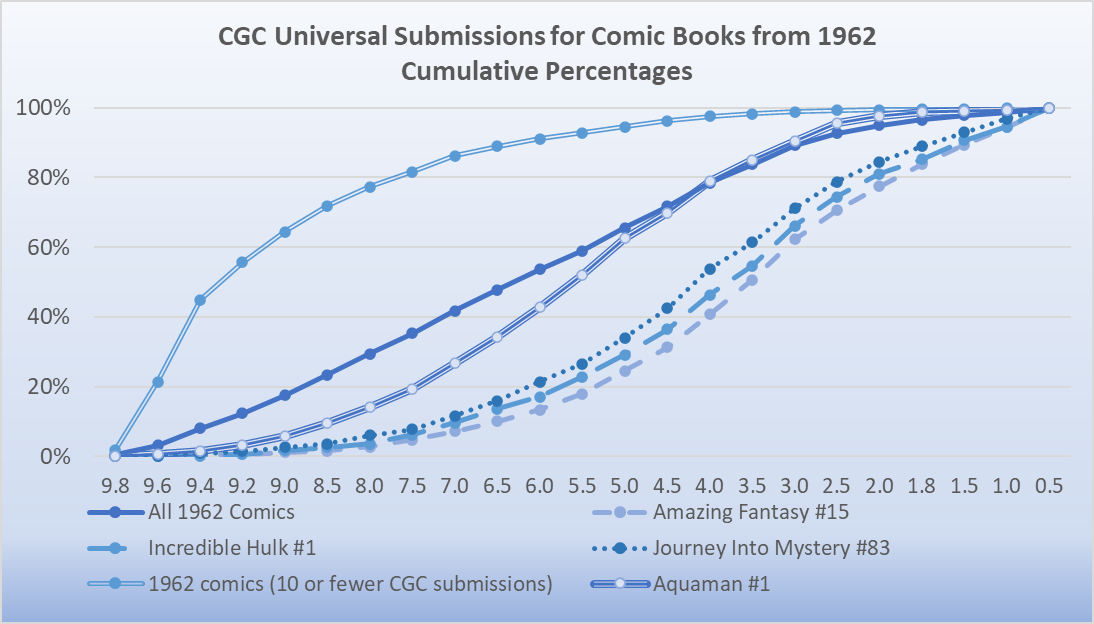
Conclusion
A temptation exists to interpret the CGC Census as representative of both graded and ungraded copies, but the more focused evidence within the CGC Census for those specific comics worth grading in all conditions may be applied more broadly to comic books of the same age. There is a significant financial incentive to submit even the lowest grade copies of certain books like Amazing Fantasy #15. The CGC Census grade distributions for Amazing Fantasy #15 are likely to be a good representation of all existing copies of not only Amazing Fantasy #15 but perhaps all 1962 comic books as well. The similarity of Incredible Hulk #1 and Journey Into Mystery #83 to Amazing Fantasy #15 CGC Census grade distributions provides evidence for this conclusion, in stark contrast to the overall CGC Census grade distributions for comics from the same year. The precision of the 25 individual grades from CGC 0.5 to CGC 10 for Amazing Fantasy #15 is too specific to apply to an estimate for other books, but groupings for raw grades as shown below give a more reasonable view of the likely grades for surviving comic books, even if the vast majority of 1962 comic books are never submitted to CGC.
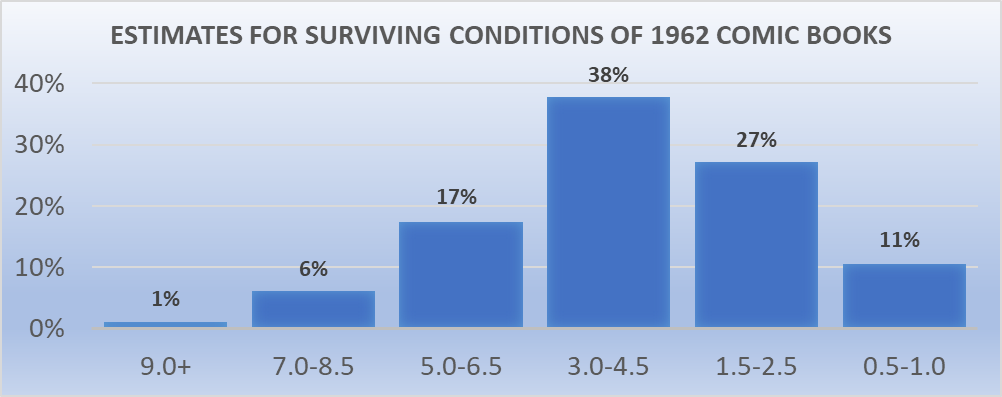
Future articles in this series are planned to expand beyond a single year, with the lofty goal of possibly approximating the grade distributions of all comic books (graded or not) from the 1930s to present.
About the Author
 |
Greg Holland has collected comic books for over 30 years and has been the administrator of the CGC Census Analysis website since 2003, currently located at CGCdata.com. He is the 1999 founder of the ValiantComics.com website and the 2004 ValiantFans.com message board. Dr. Holland holds a Ph.D. in information quality from the University of Arkansas at Little Rock and has held data science positions as research director, analyst, and administrator for government, corporations, and university. Active on the CGC Forums as ‘valiantman’ since 2002, he is also a 15+ year advisor to the Overstreet Comic Book Price Guide and contributor to later editions of the Standard Catalog of Comic Books. Greg resides in Arkansas, USA, with his wife of 23 years and their daughter. |
Related news
24 Oct 2022
Canadian Price Variants (CPVs) and GPAnalysis.com Recorded Sales
With Canadian Price Variants recorded in GPAnalysis.com for decades, what can the data tell us about rarity and value when comparing against direct editions?
Read more26 May 2022
CGC Census - A Game for the Thousandth Collector
Imagine a game where 1,000 lucky comic collectors are awarded the best available copies of comic books from the CGC Census. Where would ticket #1,000 be for the earliest appearances of favorite characters? Some winning books may surprise you.
Read more